Rowena Wiseman's Blog, page 3
September 19, 2021
How to create a free ebook cover online with Canva
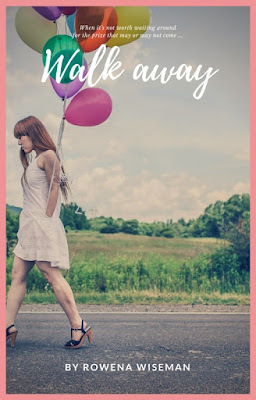
You can design an ebook cover on Canva in under 10 minutes! They have some eye-catching templates that are super easy to adapt for print, Wattpad, Kindle and more. And the best part? You don't have to have design skills, you just need a computer ...
Personally, I really like the graphic templates Canva has for ebook cover designs. It's very easy to create a unique ebook cover design using illustrations in Canva. Read to the end of this piece to discover how you can create a totally original ebook cover design that nobody else will be using! Here's a unique ebook cover design I created for Wattpad using their magic recommendations graphics (find out how to do this below!):
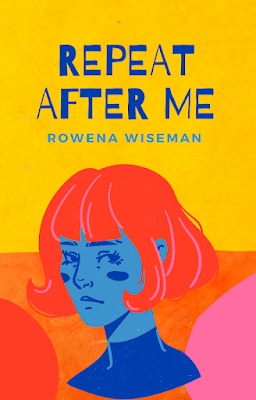
Canva was founded by Melanie Perkins from Perth. She is the great Australian startup story. At 19 she was trying to explain to her university buddies how to use Photoshop and other design software and she started thinking there has to be an easier way to do good design in under 20 clicks!
She set out to create a platform that is stylish and simple to use. Real designers must hate it! Because now literally anyone can create beautifully designed material without going to university to study design for 3 years. As the Canva motto says, they are 'Empowering the world to design'.
How to design an ebook cover 1. Go to Canva and register as a user: https://www.canva.com/
2. Type 'book cover' or 'ebook over' into the search bar. (You can also type in 'Wattpad book cover' or 'Kindle book cover').
Here you will see a range of templates categorised by fiction, non-fiction, novel, food etc. You can also search by style - modern, minimalist, illustration, or even by colour!
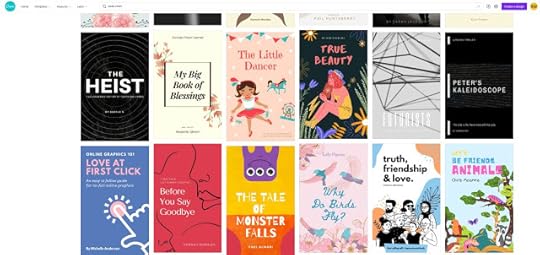
3. Scroll through the layouts and select a design template. There are free versions of paid ones starting from around $1

4. Now you want to select an image. In the left size toolbar select 'Elements' - 'photos'. You can start scrolling through the free images or use the search bar for something specific (some images may cost $1). Canva has an excellent selection of images to choose from for your ebook cover design.
Alternatively you may like to choose a royalty free image from free image sites such as Pexels or LibreStock. Use the 'Uploads' button in the left bar to upload any sourced images.
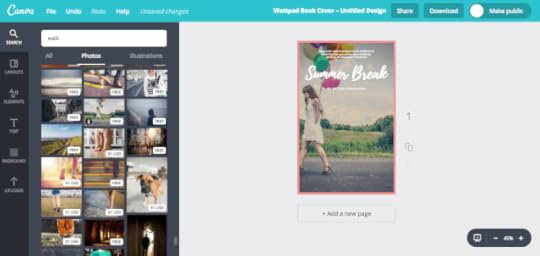
5. Add your own ebook title, author name and short blurb or endorsement by over-typing in the text boxes. You can adjust font size, type and colour and reposition the text boxes. I tend to stick close to what the Canva designers have templated, as hey, they're the designers, I'm not!
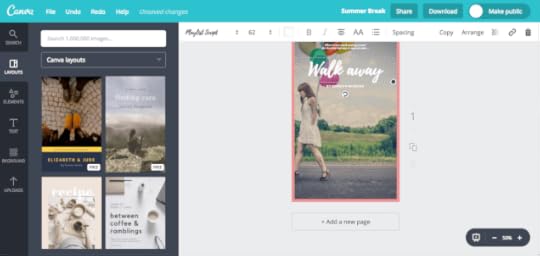
6. When you're happy with the design, click the download button in the top bar and save as a JPG or PNG.
How to use graphics to design an ebook coverI also like to use graphics when designing a ebook cover. Illustrations are a great way to make an ebook cover look unique.
1. Scroll through the templates until you find an ebook cover with a graphic and title font you like, such as this one:
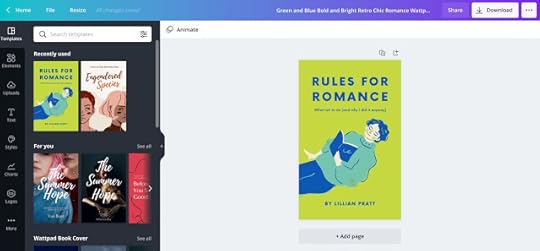
2. Remove the image by dragging and dropping outside of the frame.
3. Go to elements in the side bar, and click on graphics. Scroll through the graphics until you find a nice illustration that will go with the template.
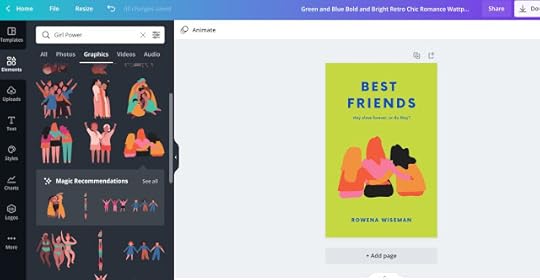
4. You can also change colours on the illustration to help it match the cover background. Have a play with the colours - this is another way to make your ebook cover look unique.

5. Use magic recommendations to find a really gorgeous illustration. You can do this by clicking on an illustration that you like - this will then bring up further illustrations by that illustrator. This is where you might find the most unique illustration to use on your ebook cover design!
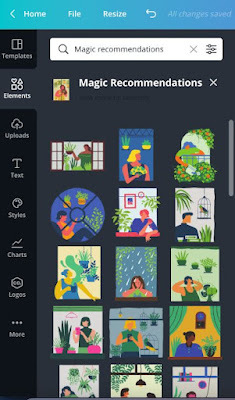
Magic recommendation can turn out like this:

Go into Canva today to design your own ebook cover. Have a play around and see what you can create!
_________________________________________
Sign up to receive a free 7-step action plan to become a published author!
-improve focus and productivity
-must-have writing software
-agents and publishers seeking manuscripts
How to design a book cover

You can design a book cover on Canva in under 10 minutes! They have some eye-catching templates that are super easy to adapt for print, Wattpad, Kindle and more. And the best part? You don't have to have design skills, you just need a computer ...
Personally, I really like the graphic templates Canva has for book cover designs. It's very easy to create a unique book cover design using illustrations in Canva. Read to the end of this piece to discover how you can create a totally original book cover design that nobody else will be using! Here's a unique book cover design I created for Wattpad using their magic recommendations graphics (find out how to do this below!):

Canva was founded by Melanie Perkins from Perth. She is the great Australian startup story. At 19 she was trying to explain to her university buddies how to use Photoshop and other design software and she started thinking there has to be an easier way to do good design in under 20 clicks!
She set out to create a platform that is stylish and simple to use. Real designers must hate it! Because now literally anyone can create beautifully designed material without going to university to study design for 3 years. As the Canva motto says, they are 'Empowering the world to design'.
How to design a book cover 1. Go to Canva and register as a user: https://www.canva.com/
2. Type 'book cover' into the search bar. (You can also type in 'Wattpad book cover' or 'Kindle book cover').
Here you will see a range of templates categorised by fiction, non-fiction, novel, food etc. You can also search by style - modern, minimalist, illustration, or even by colour!

3. Scroll through the layouts and select a design template. There are free versions of paid ones starting from around $1

4. Now you want to select an image. In the left size toolbar select 'Elements' - 'photos'. You can start scrolling through the free images or use the search bar for something specific (some images may cost $1). Canva has an excellent selection of images to choose from for your book cover design.
Alternatively you may like to choose a royalty free image from free image sites such as Pexels or LibreStock. Use the 'Uploads' button in the left bar to upload any sourced images.

5. Add your own book title, author name and short blurb or endorsement by over-typing in the text boxes. You can adjust font size, type and colour and reposition the text boxes. I tend to stick close to what the Canva designers have templated, as hey, they're the designers, I'm not!

6. When you're happy with the design, click the download button in the top bar and save as a JPG or PNG.
How to use graphics to design a book coverI also like to use graphics when designing a book cover. Illustrations are a great way to make a book cover look unique.
1. Scroll through the templates until you find a book cover with a graphic and title font you like, such as this one:

2. Remove the image by dragging and dropping outside of the frame.
3. Go to elements in the side bar, and click on graphics. Scroll through the graphics until you find a nice illustration that will go with the template.

4. You can also change colours on the illustration to help it match the cover background. Have a play with the colours - this is another way to make your book cover look unique.

5. Use magic recommendations to find a really gorgeous illustration. You can do this by clicking on an illustration that you like - this will then bring up further illustrations by that illustrator. This is where you might find the most unique illustration to use on your book cover design!

Magic recommendation can turn out like this:

Go into Canva today to design your own book cover. Have a play around and see what you can create!
______________________________________Pro-tip for writers:The Novel Factory helps you organise the notes for your novel, a plot manager to help you develop your plot, plot templates for popular genres, a character management tool, a 'go back in time' feature to see previous versions of your work!
_____________________________________
Subscribe to my newsletter for tips on reading, writing and publishing in the digital revolution and receive my top 8 tools and resources for writers for subscribers-only.
#mc_embed_signup{background:#fff; clear:left; font:14px Helvetica,Arial,sans-serif; } /* Add your own MailChimp form style overrides in your site stylesheet or in this style block. We recommend moving this block and the preceding CSS link to the HEAD of your HTML file. */
Subscribe by email
September 17, 2021
How writers can increase productivity in 25 minutes

Have you lost your ability to focus? Has TikTok destroyed your attention span? Do you find yourself wanting to swipe forward through a tedious conversation because it can no longer hold your attention? Do you sit down to write your manuscript and within minutes start thinking about those burnt caramel almonds? Perhaps you should try The Pomodoro Technique to help you focus.
I first heard about The Pomodoro Technique from a good friend of mine who used it through university to get her through her speech therapy course.
The Pomodoro Technique is a productivity method developed in the 1980s by Francesco Cirillo. It helps you break down large tasks into smaller ones, to get more done and increase your focus. This technique takes advantage of the idea that all humans are limited to about 25 minutes of intense concentration before they start getting distracted or tired.
What is The Pomodoro Technique and how does it work?You need to create a 25 minute work session, followed by a short break (usually around five minutes). You then repeat this process four times before taking an extended break of 30-60 minutes.How to get started with The Pomodoro TechniqueUse a timer - many people use their phone timer or an app. I personally use Focus Keeper - which is free and easy to use or you can use the free timer on desktop or mobile Pomodoro Timer Online.
Make a commitment - decide on what you want to get done and commit to it. Write out the tasks that you want to achieve in the day. Break them down into 25 minute chunks. It's amazing how much you can get done in blocks of 25 minutes.
Know when you are most focused, and assign the most difficult tasks in that period. For instance, if I know my focus is best from 11am until 12pm (after I have my mid-morning coffee!), I'll allocate my most challenging tasks for 11am-12.30pm (3 Pomodoros).
Because The Pomodoro Technique is focused on working in periods of 25 minutes without interruption, you can divide these intervals up any way you like and set your own goals.
Remember don't let yourself get too distracted or overstimulated when taking breaks.
Examples of what a writer can do in a 25 minute Pomodoro block without interruption:draft 250 words of a manuscript
edit 5 pages of written words
research
outline a blog post
So give it a go. Seriously, this can be one of the best productivity tools for writers that can help you improve your focus, stay on task and reward yourself with a break after the 25 minute period!
__________________________________________Pro-tip: Keep track of all your research notes and ideas in Evernote - a writer's best friend. Photograph marginalia in a book and use the optical character recognition in Evernote to find that quote! You'll never lose an idea again!
_________________________________________
Sign up to receive a free 7-step action plan to become a published author!
-improve focus and productivity
-must-have writing software
-agents and publishers seeking manuscripts
25 minutes to increased productivity for writers: The Pomodoro Technique

Have you lost your ability to focus? Has TikTok destroyed your attention span? Do you find yourself wanting to swipe forward through a tedious conversation because it can no longer hold your attention? Do you sit down to write your manuscript and within minutes start thinking about those burnt caramel almonds? Perhaps you should try The Pomodoro Technique to help you focus.
I first heard about The Pomodoro Technique from a good friend of mine who used it through university to get her through her speech therapy course.
The Pomodoro Technique is a productivity method developed in the 1980s by Francesco Cirillo. It helps you break down large tasks into smaller ones, to get more done and increase your focus. This technique takes advantage of the idea that all humans are limited to about 25 minutes of intense concentration before they start getting distracted or tired.
What is The Pomodoro Technique and how does it work?You need to create a 25 minute work session, followed by a short break (usually around five minutes). You then repeat this process four times before taking an extended break of 30-60 minutes.How to get started with The Pomodoro TechniqueUse a timer - many people use their phone timer or an app. I personally use Focus Keeper - which is free and easy to use.
Make a commitment - decide on what you want to get done and commit to it. Write out the tasks that you want to achieve in the day. Break them down into 25 minute chunks. It's amazing how much you can get done in blocks of 25 minutes.
Know when you are most focused, and assign the most difficult tasks in that period. For instance, if I know my focus is best from 11am until 12pm (after I have my mid-morning coffee!), I'll allocate my most challenging tasks for 11am-12.30pm (3 Pomodoros).
Because The Pomodoro Technique is focused on working in periods of 25 minutes without interruption, you can divide these intervals up any way you like and set your own goals.
Remember don't let yourself get too distracted or overstimulated when taking breaks.
Examples of what a writer can do in a 25 minute Pomodoro block without interruption:draft 250 words of a manuscript
edit 5 pages of written words
research
outline a blog post
So give it a go. Seriously, it can really help improve your focus by staying on task and rewarding yourself with a break after the 25 minute period.
__________________________________________Pro-tip: Keep track of all your research notes and ideas in Evernote - a writer's best friend. Photograph marginalia in a book and use the optical character recognition in Evernote to find that quote! You'll never lose an idea again!
__________________________________________
Subscribe to my newsletter to receive my subscriber-only top 8 tools and resources for writers.
#mc_embed_signup{background:#fff; clear:left; font:14px Helvetica,Arial,sans-serif; } /* Add your own Mailchimp form style overrides in your site stylesheet or in this style block. We recommend moving this block and the preceding CSS link to the HEAD of your HTML file. */ Subscribe
September 9, 2021
Wattpad vs Radish? Which is the best online writing app?

So you've written a novel and would like to publish it online. You've looked into various online publishing platforms and are considering which one is better - Wattpad or Radish Fiction?
I have novels on both Wattpad and Radish Fiction. I like both, for different reasons. I'm also a member of a Facebook group - Writing and Selling on Fiction apps - so I put the question out to other members of the group for their opinions too.
Should you publish your novel on Wattpad or Radish?
Wattpad vs Radish for communityWattpad is good for the community and the social side. Readers on Wattpad can be like cheerleaders for you - which is great to help motivate you as a writer. I loved the experience of writing a young adult novel on Wattpad so much, with such a positive and insightful community, that I went on to write two more novels for young readers. So if you're looking for positive encouragement as an author - head to Wattpad.
Radish also has a comments function - but don't expect the kind of love as you receive on Wattpad from readers. Mostly I've been told off on Radish for my chapters being too short or my love scenes not being long enough! But this could be an age factor as well - my readers on Wattpad are young adults whereas my stories on Radish are for older women.
Wattpad or Radish? Depends on the genreIt might depend on which genre you have written to whether your book will be better off on Wattpad or Radish.
Wattpad is better for young adult, new adult, paranormal and sci-fi. Radish is better for romance, mystery, thriller and fantasy.
Before you make the choice to publish your novel on either Wattpad or Radish - spend some time on each platform and observe which books are featured on the homepage and where your book might fit better.
Radish is curated. You have to apply to Radish to be accepted into the platform. If you are accepted, you are one of around 2000 authors on the platform (currently). You might even decide to apply to Radish and if you are not accepted, then you can put your novel on Wattpad.
Radish versus Wattpad for monetizationWattpad is like going to the casino. You may or may not win. The opportunities on Wattpad are massive - they have a paid program, as well as Wattpad books - where your book could potentially be traditionally published by a major publisher, as well as Wattpad studios - where your book could be picked up by a TV or movie studio.
Wattpad collects the data on what stories are doing well and resonating with readers - and feeds this back to the team to contact writers for paid opportunities. In a way, they are working like literary agents and creating deals for authors on Wattpad. However, it is not guaranteed that you will make any money on the platform.
If you would like to submit your story to the Wattpad paid programs, fill out the story notes in your story and tick which opportunities you are interested in:
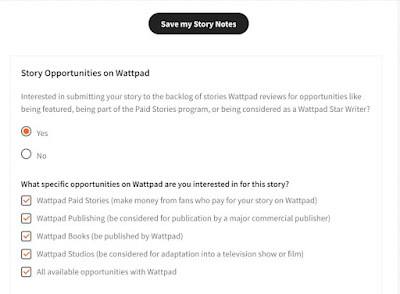
With Radish you have more of a guarantee of getting paid, if you are accepted into the platform. How much you are paid, depends on how many reads your novel is getting as people pay per chapter. Radish has recently changed how much it pays authors, and while this has decreased a little in the last couple of months, Radish has assured authors that promotion of their works will increase, which should eventually result in an increase in payments.
Radish is positioning itself as the 'Netflix' for serialised fiction. They hire professional writers to craft stories for the platform via Radish originals. So if you are lucky enough to be accepted as a writer with Radish - you are among professional writers and the quality on Radish is probably better than the tens of thousands of novice writers on Wattpad.
With Radish, you can apply for your novel to be featured in a monthly promotion. Just make sure you are reading the Radish newsletters or writers announcements for opportunities to be promoted on the homepage. Payments often improve for the month when your novel is promoted.
On Radish, you have to select a pricing model for your novel. They have a number of different pricing models:
Premium = three coins to access and read.
Freemium = three coins to access and read each episode, however, each episode will be made free to read a minimum of seven days after publication
Wait-to-Unlock = readers can wait a designated timeframe for it to unlock for Free or they can pay to unlock it early (you can choose how many chapters you want on the Wait-to-Unlock plan too)
Free = episodes are completely unlocked and readers will not have to pay to read.
____________________________________________________________Pro tip:
Need help writing your latest novel? Check out the Novel Factory - the ultimate novel writing software for writers that includes plot templates, character questionnaires, drag and drop plotting tools and so much more. You can try it for 30 days completely free, no credit card required.______________________________ ______________________________
Wattpad versus Radish for exclusivityThis is a big concern for authors who publish their work on digital platforms. When I asked other authors on the Fiction app group whether they thought Wattpad or Radish was better, a number of them said Radish because it was non-exclusive. To be accepted into the paid program on Wattpad, your novel can only be on Wattpad exclusively.
However - you need to read the exclusivity clauses carefully as some of the pricing models on Radish also require exclusivity.
Communicating with Wattpad or Radish as an authorI've found staff at both Wattpad and Radish are great to communicate with. If you have queries - you can send them a message and someone will get back to you in a few days.
An editor at Radish did a light edit of my story before it was published. She was lovely and positive to work with.
Wattpad has been in touch with me about becoming a featured author in the early days and more recently about some interest they had from an external party about one of my stories.
I've found staff at both Wattpad and Radish extremely professional and pleasant to work with.
So the biggest thing, I think, when deciding whether to publish your story on Radish or Wattpad is to consider what genre your novel is and where would it would find the most readers, whether you are happy for your novel to be exclusive or non-exclusive, and whether you are happy with a guaranteed pay or the gamble of a publishing or studio deal.
Good luck with it! Both are great in my opinion!
Also read:5 reasons you should be on Wattpad100,000 reads and 8 things I love about WattpadWhy Radish Fiction is the next big thing
_________________________________________
Sign up to receive a free 7-step action plan to become a published author!
-improve focus and productivity
-must-have writing software
-agents and publishers seeking manuscripts
Wattpad vs Radish

So you've written a novel and would like to publish it online. You've looked into various online publishing platforms and are considering which one is better - Wattpad or Radish Fiction?
I have novels on both Wattpad and Radish Fiction. I like both, for different reasons. I'm also a member of a Facebook group - Writing and Selling on Fiction apps - so I put the question out to other members of the group for their opinions too.
Should you publish your novel on Wattpad or Radish?
Wattpad vs Radish for communityWattpad is good for the community and the social side. Readers on Wattpad can be like cheerleaders for you - which is great to help motivate you as a writer. I loved the experience of writing a young adult novel on Wattpad so much, with such a positive and insightful community, that I went on to write two more novels for young readers. So if you're looking for positive encouragement as an author - head to Wattpad.
Radish also has a comments function - but don't expect the kind of love as you receive on Wattpad from readers. Mostly I've been told off on Radish for my chapters being too short or my love scenes not being long enough! But this could be an age factor as well - my readers on Wattpad are young adults whereas my stories on Radish are for older women.
Wattpad or Radish? Depends on the genreIt might depend on which genre you have written to whether your book will be better off on Wattpad or Radish.
Wattpad is better for young adult, new adult, paranormal and sci-fi. Radish is better for romance, mystery, thriller and fantasy.
Before you make the choice to publish your novel on either Wattpad or Radish - spend some time on each platform and observe which books are featured on the homepage and where your book might fit better.
Radish is curated. You have to apply to Radish to be accepted into the platform. If you are accepted, you are one of around 2000 authors on the platform (currently). You might even decide to apply to Radish and if you are not accepted, then you can put your novel on Wattpad.
Radish versus Wattpad for monetizationWattpad is like going to the casino. You may or may not win. The opportunities on Wattpad are massive - they have a paid program, as well as Wattpad books - where your book could potentially be traditionally published by a major publisher, as well as Wattpad studios - where your book could be picked up by a TV or movie studio.
Wattpad collects the data on what stories are doing well and resonating with readers - and feeds this back to the team to contact writers for paid opportunities. In a way, they are working like literary agents and creating deals for authors on Wattpad. However, it is not guaranteed that you will make any money on the platform.
If you would like to submit your story to the Wattpad paid programs, fill out the story notes in your story and tick which opportunities you are interested in:

With Radish you have more of a guarantee of getting paid, if you are accepted into the platform. How much you are paid, depends on how many reads your novel is getting as people pay per chapter. Radish has recently changed how much it pays authors, and while this has decreased a little in the last couple of months, Radish has assured authors that promotion of their works will increase, which should eventually result in an increase in payments.
Radish is positioning itself as the 'Netflix' for serialised fiction. They hire professional writers to craft stories for the platform via Radish originals. So if you are lucky enough to be accepted as a writer with Radish - you are among professional writers and the quality on Radish is probably better than the tens of thousands of novice writers on Wattpad.
With Radish, you can apply for your novel to be featured in a monthly promotion. Just make sure you are reading the Radish newsletters or writers announcements for opportunities to be promoted on the homepage. Payments often improve for the month when your novel is promoted.
On Radish, you have to select a pricing model for your novel. They have a number of different pricing models:
Premium = three coins to access and read.
Freemium = three coins to access and read each episode, however, each episode will be made free to read a minimum of seven days after publication
Wait-to-Unlock = readers can wait a designated timeframe for it to unlock for Free or they can pay to unlock it early (you can choose how many chapters you want on the Wait-to-Unlock plan too)
Free = episodes are completely unlocked and readers will not have to pay to read.
Wattpad versus Radish for exclusivityThis is a big concern for authors who publish their work on digital platforms. When I asked other authors on the Fiction app group whether they thought Wattpad or Radish was better, a number of them said Radish because it was non-exclusive. To be accepted into the paid program on Wattpad, your novel can only be on Wattpad exclusively.
However - you need to read the exclusivity clauses carefully as some of the pricing models on Radish also require exclusivity.
Communicating with Wattpad or Radish as an authorI've found staff at both Wattpad and Radish are great to communicate with. If you have queries - you can send them a message and someone will get back to you in a few days.
An editor at Radish did a light edit of my story before it was published. She was lovely and positive to work with.
Wattpad has been in touch with me about becoming a featured author in the early days and more recently about some interest they had from an external party about one of my stories.
I've found staff at both Wattpad and Radish extremely professional and pleasant to work with.
So the biggest thing, I think, when deciding whether to publish your story on Radish or Wattpad is to consider what genre your novel is and where would it would find the most readers, whether you are happy for your novel to be exclusive or non-exclusive, and whether you are happy with a guaranteed pay or the gamble of a publishing or studio deal.
Good luck with it! Both are great in my opinion!
Subscribe to my newsletter to receive my subscriber-only top 8 tools and resources for writers.
#mc_embed_signup{background:#fff; clear:left; font:14px Helvetica,Arial,sans-serif; } /* Add your own Mailchimp form style overrides in your site stylesheet or in this style block. We recommend moving this block and the preceding CSS link to the HEAD of your HTML file. */ Subscribe
September 8, 2021
The Manuscript Academy for querying agents

I'm a long-time listener of The Manuscript Academy podcast. Their episodes with literary agents live reading query letters and saying whether they would request the full manuscript are so informative for writers in the process of querying agents.
The Manuscript Academy has a monthly membership option or you can pay $99 for a well known literary agent to read the first 10 pages of your manuscript and your query letter and give you feedback in a 15 minute zoom session.
I'd just finished a new novel and I was feeling super good about it - it's one of the more commercial books I've written and I thought it might have some broader appeal.
So when The Manuscript Academy announced new agent sessions and I saw one of the US agents I've had my eye on had a session available at a non-ridiculous hour for the Australian timezone, I booked in.
Within a couple of weeks, I got an email from said agent with initial comments, along with an attachment of the first 10 pages of my manuscript with detailed mark ups.
The comments burst my bubble. I had clearly not written a great piece of fiction.
The agent said 'slow down' and 'make your readers care about your character before you launch into the action.'
The agent also made suggestions about how I could improve my query letter.
Based on the agent's feedback, I feel like I need to rewrite the beginning of my novel. They've given me some clear direction on how to begin again - and also made me think more about how can I make readers care more for my character.
I'm pleased that I did the Manuscript Academy critique before starting to send out query letters to agents, which is what I'd usually do at this stage after finishing a few drafts of a novel (thinking it was good enough).
The Manuscript Academy agent gave me their response to my query letter and why they didn't think my first 10 pages were making the cut. This is valuable information for me to have - and information that I wouldn't have had, if I'd started sending out my queries and received only deadly silence.
The deadly silence would have made me give up on this novel. This agent's honest criticism, makes me want to work harder on this novel - and give it the best chance I can.
So should you do a manuscript academy critique? Yes, you definitely should. But don't go into it expecting that you're going to meet an agent who is going to fall in love with your story.
Go into it expecting that you are going to get honest feedback. Go into it knowing you're going to come out of it having to do more work.
The road to getting published is paved with hope, criticism and rejection. Give it time. Take the criticism. Learn from it. Improve it. Hope again.
See my previous blog post on inspiration comes from rejection. And Which publishers accept unsolicited manuscripts.
____________________________________________
Pro-tip: You can also use book editing software! Pro Writing Aid assists with style, over use of cliches or repetitive words, pacing and readability.Try their grammar check here:
Enter some text and click button below to see improvements. (Make some some erors like this ones to sea how it worx.)
Check Text
Use this link to get 20% off Pro Writing Aid.
_________________________________________
Sign up to a free 7-step author journey program!
Everything you need to know about writing and publishing in the digital revolution!
The Manuscript Academy critique - for querying agents. Here's my review

I'm a long-time listener of The Manuscript Academy podcast. Their episodes with literary agents live reading query letters and saying whether they would request the full manuscript are so informative for writers in the process of querying agents.
The Manuscript Academy has a monthly membership option or you can pay $99 for a well known literary agent to read the first 10 pages of your manuscript and your query letter and give you feedback in a 15 minute zoom session.
I'd just finished a new novel and I was feeling super good about it - it's one of the more commercial books I've written and I thought it might have some broader appeal.
So when The Manuscript Academy announced new agent sessions and I saw one of the US agents I've had my eye on had a session available at a non-ridiculous hour for the Australian timezone, I booked in.
Within a couple of weeks, I got an email from said agent with initial comments, along with an attachment of the first 10 pages of my manuscript with detailed mark ups.
The comments burst my bubble. I had clearly not written a great piece of fiction.
The agent said 'slow down' and 'make your readers care about your character before you launch into the action.'
The agent also made suggestions about how I could improve my query letter.
Based on the agent's feedback, I feel like I need to rewrite my novel. They've given me some clear direction on how to begin again - and also made me think more about how can I make readers care more for my character.
I'm pleased that I did the Manuscript Academy critique before starting to send out query letters to agents, which is what I'd usually do at this stage after finishing a few drafts of a novel (thinking it was good enough).
The Manuscript Academy agent gave me their response to my query letter and why they didn't think my first 10 pages were making the cut. This is valuable information for me to have - and information that I wouldn't have had, if I'd started sending out my queries and received only deadly silence.
The deadly silence would have made me give up on this novel. This agent's honest criticism, makes me want to work harder on this novel - and give it the best chance I can.
So should you do a manuscript academy critique? Yes, you definitely should. But don't go into it expecting that you're going to meet an agent who is going to fall in love with your story.
Go into it expecting that you are going to get honest feedback. Go into it knowing you're going to come out of it having to do more work.
The road to getting published is paved with hope, criticism and rejection. Give it time. Take the criticism. Learn from it. Improve it. Hope again.
See my previous blog post on inspiration comes from rejection.
Subscribe to my newsletter to receive my subscriber-only top 8 tools and resources for writers.#mc_embed_signup{background:#fff; clear:left; font:14px Helvetica,Arial,sans-serif; } /* Add your own Mailchimp form style overrides in your site stylesheet or in this style block. We recommend moving this block and the preceding CSS link to the HEAD of your HTML file. */ Subscribe
September 2, 2021
How to build your author platform: 15 top tools

It's important for authors to connect with their readers and sell books, but the internet is also a crowded space, so you need a plan. Over the years, I've found inexpensive tools and time-saving automations to help with my blog and social media platforms.
Here are my top 15 tools for growing your author platform and building an online audience.
Create an author websiteA website for authors is like a business card: it's your chance to show off your personality and your writing. Check out GoDaddy for inexpensive website templates and hosting. I built my blog over 10 years ago using Blogger, which is free, and I use Blogger templates from creators on Etsy - which cost around $20.
The most important pages to have on an author website are an about me page (listing publications, awards and a little bit about yourself), a page for any published books, a contact page and a subscribe page.
Pick one or two social media platforms and do them wellDon't spread yourself too thin across social media - it's better to choose one or two platforms and do them really well. Otherwise, you'll suffer from social media fatigue. Good social media platforms for writers are: Twitter, Instagram, TikTok and Facebook.
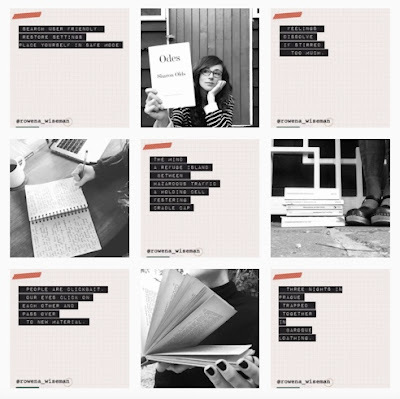
Add a Beacons page to your social media bios to feature pages on your website. A Beacons page is a great way to direct people straight to your books page, best pages on your blog or where else they can find you on social media.

Think carefully about how you want to present yourself on each platform, for example, my Instagram page is stylised in black and white and I only post poetry or short snippets from my novel. I see my Instagram page as showcasing my actual writing. On Twitter I post links to my blog. On TikTok I'm just silly.
Automate your social mediaAutomate, automate, automate. Find ways to save time or you'll risk social media burnout!Missinglettr automates blog posts to social media so you can literally create 10 social media posts on 4 platforms in two minutes. The AI in Missinglettr grabs quotes from your blog post and pairs them with images. It drafts social media posts for you to review. You can then edit the posts and click launch campaign! It's as easy as that. You can start a free 14-day trial here.
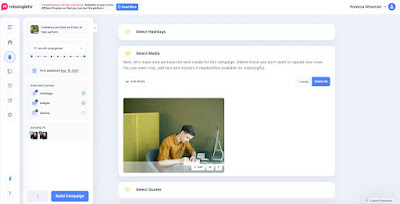
I also like Buffer to schedule posts to Twitter. After they are posted, I can reuse them again. It's a great way to ensure you are posting consistently.
And finally, for Instagram I use Later to schedule posts - I especially love the preview function which allows you to see how the grid will look before you post. So no more face palm moments when two images don't look good when placed close together!
Create a book review accountThe people you want to connect with most as a writer are readers. The best place to connect with readers is on book review platforms like Goodreads or The StoryGraph. Create a profile and start reviewing the books that you are reading. Writing book reviews also helps you to process and articulate what you have read. Follow other readers on these sites and start to build a community of readers.
Create an author email listAn email list is a way to build your tribe. I use Mailchimp for my email newsletters. If you have under 2000 subscribers the platform is free to use. They have great templates and offer reporting on the number of opens and clicks so you can see if your emails are hitting the right note. Make sure you have a 'subscribe' button on your website, so people can sign up easily from there.
FiverrFiverr is an online marketplace of freelancers who can help you with all sorts of author platform building tasks. I've commissioned freelancers from all around the world to help me with my website, fix my Google Analytics, improve the SEO of my website, assist with building my Instagram following and more.
You can also find beta readers, editors and proofreaders on Fiverr or book designers to help you with your book cover design. Read the individual's bio and reviews before commissioning them - to see what others have said about their services.
Take a really good author headshotYou need to have a good profile picture of yourself for your website and social media platforms. Personally, I hate anyone taking my photo - but I've worked out a way to take a good selfie. Check out my previous blog post on how to take a really good author headshot!
Use Jarvis AI creative writing assistant for blog posts and social mediaSo although I write novels, I actually don't enjoy writing captions for social media posts or birthday cards! Jarvis AI is a brilliant writing assistant and can help you compose introductions to blog posts, email headlines and social media captions. Jarvis AI is smart and witty and can generate a number of different options for you - that you can then tailor for your own needs.
Using this artificial intelligence can also improve your copywriting skills and teach you content marketing fundamentals such as the AIDA framework: Attention - Interest - Desire - Action and PAS framework: Problem - Agitate - Solution. You just plug in a content description, choose a tone of voice and voila - Jarvis AI has generated your text for you!

I even tested Jarvis AI's creative writing skills by entering the plot of one of my novels - and it actually performed quite well in writing a fictional paragraph! You can see my blog post on Can AI help you write a novel here.
Create an audiobook sample of your book with SpeecheloThis product is amazing! You can create a Hollywood-actor-sounding audio chapter of your book as a sample on your website! No more robot-sounding voiceovers ... Speechelo sounds like a professional voiceover artist. I'm not kidding. Go to the website and take a listen now! Just upload your chapter to Speechelo to create an audio file.
You could even use Speechelo to create interesting voiceovers for social media posts on TikTok or Instagram reels or other short video platforms.
You need organic traffic to your website by having SEO that will draw people to your website via a search engine. Someone from a digital advertising firm once told me that SEO is actually much better than paying for ads on Facebook or Instagram.
Okay, I'm going to admit, I don't know a lot about SEO. But I have been using the super easy content tool in Surfer SEO to write my blog posts - to make sure they are rich with SEO keywords. I know that SEO is really technical and there's a lot to learn, but I feel as though this is the least I can do to make sure my blog posts have important keywords that will rank on Google. The Surfer SEO content score helps to encourage me to write more headings, longer text and alt text on images. It's a good visual reminder for how to improve the content on my blog posts. Personally, I've signed up to the hobby plan at $29 a month which gives me 5 content editor opportunities a month.
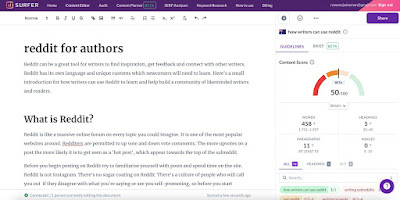
Subscribe to my newsletter to receive my subscriber-only top 8 tools and resources for writers.
#mc_embed_signup{background:#fff; clear:left; font:14px Helvetica,Arial,sans-serif; } /* Add your own Mailchimp form style overrides in your site stylesheet or in this style block. We recommend moving this block and the preceding CSS link to the HEAD of your HTML file. */ Subscribe
August 26, 2021
Social media for authors: Missinglettr automates it!

This could be the best social media tools for authors out there! With Missinglettr you can create a year's worth of social media content in minutes. Missinglettr scans new blog articles you have written and creates social media posts that you can post to Twitter, Instagram, Facebook, LinkedIn and other social media networks automatically. The AI is so sophisticated it actually drafts text for social media posts based on quotes from your blog post and compiles images for you to use.
Missinglettr helps writers to be consistent with social media posting, increase their social media presence and avoid social media burnout.
How Missinglettr's Automatically Generated Social Media Campaign works for authorsFirst you will need to link your author blog and connect social media profiles in Missinglettr.
Go to the Campaign page - this is where you are able to generate a drip feed campaign that will automatically post to your selected social media platforms for the next 12 months.
You can review the campaigns that Missinglettr has generated by selecting the relevant blog post.
Missinglettr will automatically generate hashtags that you can keep or delete. You can also create your own.
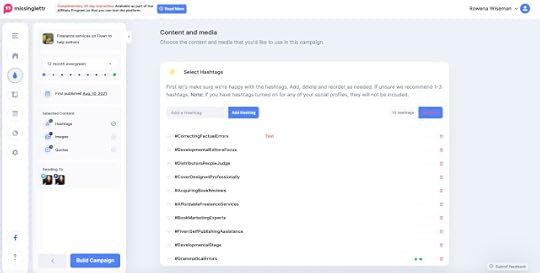
You can then select any media that you would like in the campaign. This is usually drawn from images you have used in your blog post
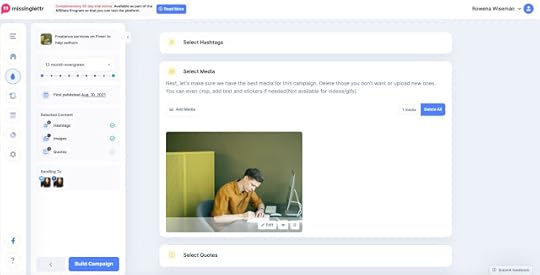
Missinglettr will automatically generate social media captions for your social media campaigns by drawing on quotes from your blog post. The AI will bold the quotes they see as the most relevant, however, here you have the opportunity to review each suggestion and edit them. Just click the delete button for any you don't want to use or the plus button to add more to your campaign. This part is super easy and a magical way to promote your blog posts.
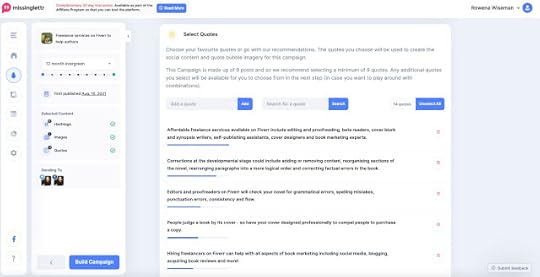
You press 'build campaign' and Missinglettr cleverly composes a social media campaign to promote your blog posts. Now you get to review these posts. Again you can edit the text and also select which social media accounts you want these posts to feed to. And you can see the quote bubbles that Missinglettr has designed to get attention on your favourite social media channels.
Here's a few examples that Missinglettr created for me:
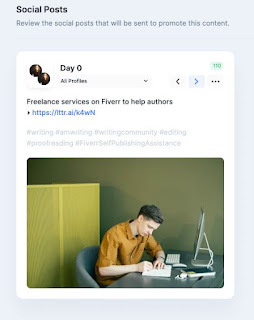
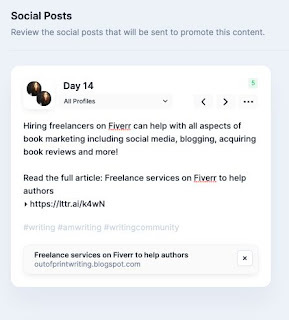

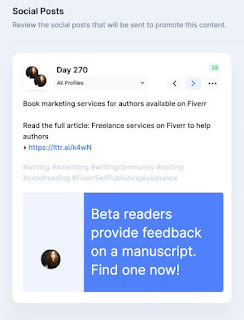
Then you press 'launch campaign' and confirm that the content is yours. This is how simple it is to create 10 social media posts across two platforms in two minutes, to be spaced out over the whole year.
Reshare social media content with the Curate function in MissinglettrAnother great function with Missinglettr is the 'Curate' tab which draws up engaging social media content for you to share with your audience. Again, the algorithm has carefully selected social media posts about writing just for you. Just click the share button and post or schedule.
See your whole month social media schedule in MissinglettrClick on the schedule tab to see the whole month of social media content that Missinglettr has scheduled - this is such a great tool for social media marketing
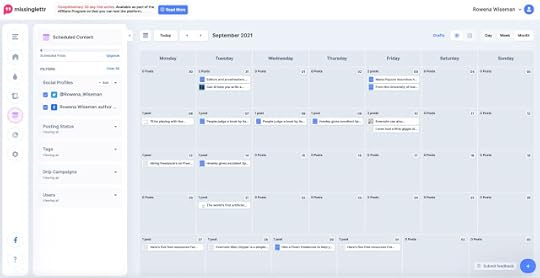
Other great functions of Missinglettr
There's a detailed analytics tab where you can see clicks and countries of origin. And one function that I particularly like, is that you can connect your blog posts so that they re-post on your Medium account automatically.
Get in and explore Missinglettr. Start a 14-day free trial. You can set up 9 social media platforms, schedule 3000 posts and promote up to 10 curate posts in the trial period!



